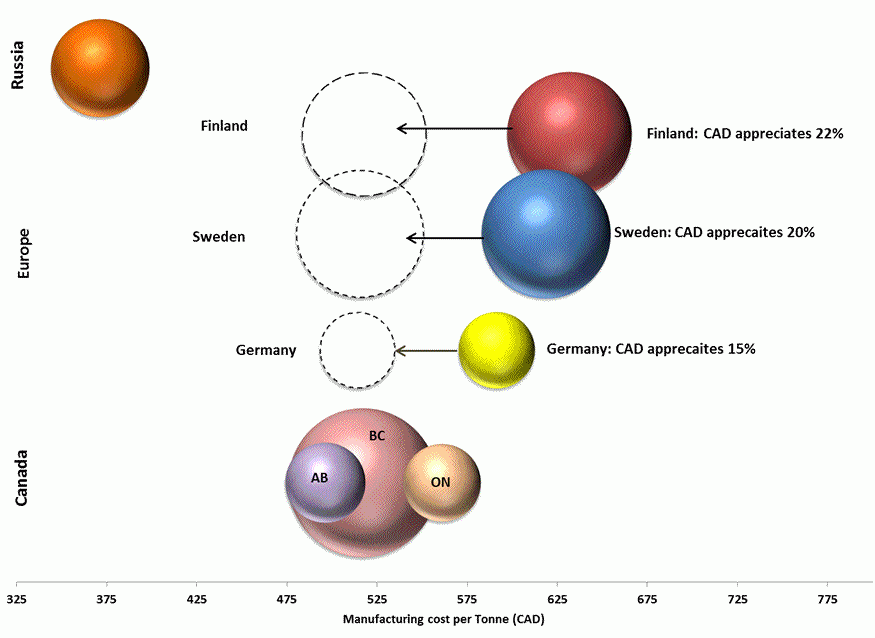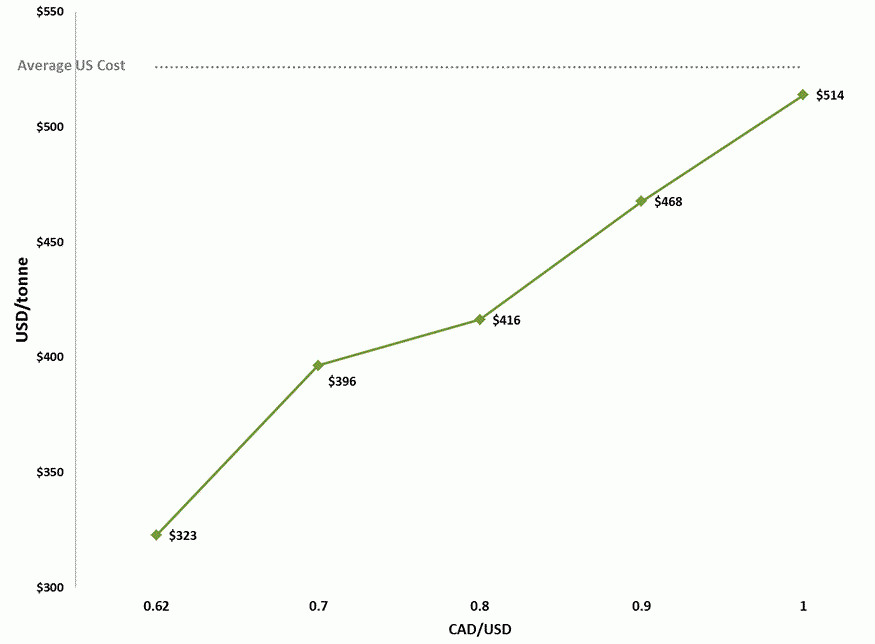Selective Cuttings
Exchange rate movements and competitiveness in the global NBSK market
February 7, 2017
Canada has the largest share of the northern bleached softwood kraft pulp (NBSK) capacity (>40%), and our mills are among the lowest cost global producers.
However, exchange rate movements could alter our position in a globally competitive market.
We examine the importance of exchange rate movements in two scenarios for NBSK market pulp producers:
- Canada relative to large European competitors. Large European competitors include Russia, Finland, Sweden, and Germany;
- Canada relative to the United States. The United States is a small producer, but an important market given its size and proximity to Canada.
Scenario 1
As seen in Graph1, average production costs in the three large Canadian provinces are significantly lower than in Finland, Sweden, and Germany. This is in large part due to high fibre cost in the European countries. As a result, the Canadian dollar would have to appreciate beyond historical highs against the Euro and Swedish Krona to hinder our cost competitiveness.
Graph 1: Canadian dollar appreciation against Euro and Swedish Krona scenarios
For example, the Canadian dollar would need to appreciate 15% against the Euro to reduce German production cost to Canadian levels. An even larger 22% appreciation against the Euro would be required to lower Finnish production costs to the Canadian levels. Similarly, the Canadian dollar would have to appreciate 20% against the Swedish Krona to bring Sweden’s cost down to Canadian levels.
The good news for Canadian producers is that these scenarios seem unlikely as the dollar has not been traded at those levels in recent years. A 22% appreciation against the Euro would actually take it past the historical high of August 2012 (CAD/Euro 0.81), and a 20% appreciation against the Swedish Krona would take it beyond the historical high of 7.5 (June 2010).
Canada also remains more competitive than European producers after accounting for transportation cost to the largest market, China. However, once transportation costs are considered, the Canadian dollar would only have to appreciate 6% against the Euro for German costs to China to equal that of Canada’s. This would imply a Canadian dollar-Euro exchange rate trading near its historical upper bound, which is unlikely in the short-term.
The only European country that can currently compete on cost with Canadian producers is Russia. Russia remains the global lowest cost producer under any plausible currency scenario given their significant labour cost advantage and low fibre and energy costs. Additionally, Russia has a proximity advantage to the large Chinese market and will remain the lowest cost supplier of NBSK.
Scenario 2
Closer to home, Canada is more competitive than the US in part due to lower energy, labour and fibre costs. This relationship holds in all scenarios where the exchange rate ranges from 70 cents to parity with the US dollar.
Graph 2: Changes in Canadian production cost with CAD-USD exchange rate movements
Over the short-term, the exchange rate is forecasted around 75-80 cents, which would give Canada about USD100/tonne cost advantage. This advantage remains after we factor in transportation cost to the US market. In fact, even with transportation costs Canada is more competitive than the US. Only once the exchange rate reaches parity would the US producers gain a slight advantage of $5 per tonne advantage. However, this latter scenario is very unlikely in the medium term.
Overall, the low Canadian dollar supports the industry at a time when it is challenged by continued shrinking printing and writing paper demand, additional softwood kraft pulp capacity coming online in the next few years, and strong competition from low-cost hardwood kraft pulp producers.


